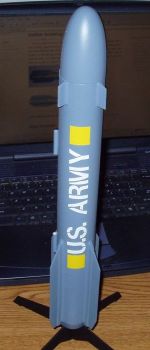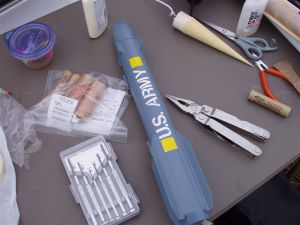Scratch Hellfire 1.6 Original Design / Scratch Built
Scratch - Hellfire 1.6 {Scratch}
Contributed by Peter Stanley
| Manufacturer: | Scratch |

Brief:
This is a 1.6" diameter scratch built Hellfire. The design is based on
measurements I took of an inert Hellfire training missile at an air show in
October 2005. It has a 24mm motor mount and uses a parachute for recovery.
Construction:
Here's a parts list:
- 1 Estes PNC-60MS nose cone
- 1 Body tube, BT-60 x 12.0257"
- 1 Body tube, BT-55 x 1.0750"
- 1 Centering ring, BT50-55
- 1 Centering ring, BT55-60 (homemade, see tip on how I did this)
- 1 Engine hook
- 1 Body tube, 24 mm
- 1 Centering ring, BT50-60
- 1 Centering ring, BT50-60
- 1 Parachute, 18" nylon
- 4 Forward Fins, Balsa
- 4 Rear Fins, Balsa
- 8 Rear Fins strips, Balsa
- 2 Launch lug, LL-1/8
- 1 Paper tail cone

I printed a wrap-around fin guide using free rocket template software from the Calculators and Tools page. I marked the fin lines and drew them across the length of the tube using a piece of aluminum angle. I drew a center line between two the lines for the launch lugs. For the fins I used 1/16" balsa. I cut them from templates printed out of RockSim and soaked them with CA. When soaking with CA, it helps to press the pieces between sheets of wax paper on a flat surface with some weight on top. I used a stack of books on a glass table top. If the fins aren't kept flat they will warp when the CA cures. This is a tip I learned from building The Launch Pad kits. It adds a lot of strength but with adding little weight. The drawback is it's easy to get the fumes in your nose, even with adequate ventilation and protection. In my case, my nose is stopped up for a week. I ordered all of the parts from BRS Hobbies, except for what I made. There is a featured tip I wrote which illustrates the tail cone section and how to make a custom centering ring. For the tail cone, I printed the shroud using the above mentioned freeware tools onto index card stock. I forgot to include a motor hook and have to use tape to secure the motors in place. The motor mount is fairly recessed in my design, so motor retention with friction fitting is not ideal. The shock cord mount is an Estes-style tri-fold paper mount. Before gluing, I added a loop of Kevlar® thread. The knot of the loop is in the inner fold of paper and the loop sticks out. I suggest doing whatever works for you though. I'm using a standard Estes 1/8 inch shock cord which is tied to a small snap swivel that attaches to the Kevlar® loop. The nose cone is a standard plastic Estes PNC-60S. The is the closest I could find that resembles the Hellfire, but it is not really shaped like the end of a Hellfire. I added about five ounces of lead and clay to the nosecone.
Finishing:
I pre-finished the body tube and fins before building using Elmer's Fill 'n'
Finish. After attaching the fins, I applied epoxy clay to the fin joints then
added one coat of F 'n' F to the joints and sanded. I used one coat of primer
and one coat of paint. I really screwed up the color on mine. From staring at
the pictures I was convinced it was a bluish-gray color, but now I'm thinking
it was more greenish-gray. I used one inch vinyl letters for the lettering. I
cut out segments through the centers before applying to create a stencil look.
The yellow blocks are one inch by one inch cut from some vinyl sheet material
that I purchased from a hobby shop.
Flight:
I have flown it twice. One flight on a C11-3 and the other on a D12-5. I used
cellulose insulation for recovery wadding and masking tape to friction fit the
motors. Both flights had a straight boost with deployment at apogee.
Recovery:
I think I spec'ed an 18 inch chute in RockSim but used a 12 inch parachute for
both flights. One was a plastic Estes chute and the other was a silk flare
chute. The extra nose weight makes the nose cone swing around like a wrecking
ball, so you want to make sure that it can't hit the body tube. On the 12 inch
chutes the descent was a little fast but not enough to damage the rocket.
Summary:
The PROs of the rocket are that it's really cool looking and could be easily
scaled up or down. I've recently started getting into scale rocketry and
perfect or not, it was rewarding to make something from data that I collected
myself.
The main CON is the CP is so far forward that it requires lots of nose weight to be stable. Also, the forward fins have to be perfect or the rocket will fly crooked.
 |
 |